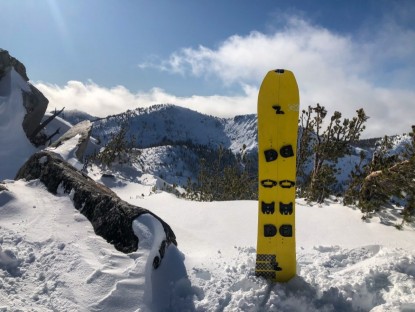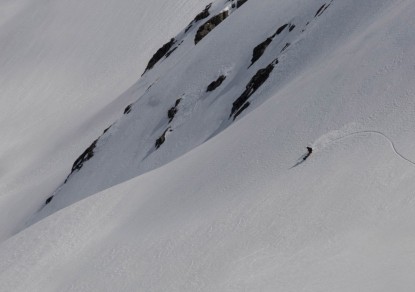K2 Ultrasplit Review
Our Verdict
Our Analysis and Test Results
This board scored well across most categories. It was stiff, but still playful and fun to shred. The holes at the tip and tail distinguish it from all the other splits in our review. These holes allow it to pair with proprietary K2 skins and K2 Rescue Shovel Plus to create a rescue sled. For an affordable splitboard, these specialized features distinguish this board from the others in our test.
Performance Comparison
The Ultrasplit is a directional twin, which basically means that it is a twin tip. The nose is 6cm high and the tail is 4.5cm high, which is the directional part of the twin. The default binding position is shifted back towards the tail, but if you desire a more centered stance, that can also be achieved. Twin shapes are a bit biased towards freestyle, and the riders who cut their teeth on twin boards and prefer them. The primary feature avoided by a twin shape is taper, and soft snow float might be a concern on some twin boards although it wasn't the case with this model. This splitboard features a relatively narrow nose that reaches its widest point about 23cms down from the front. This type of shape is more common in the ski world (DPS Wailer 112s come to mind) than in the splitboard world, but it works well for this board in particular.
Powder
This splitboard floats well in powder. The “flat” camber between the bindings and rocker near the nose and tail work great for rising to the top of soft snow. While the camber is very close to being flat between the bindings, there is just under 1cm of camber. Similar flat/rocker profiles have been employed by K2 and other manufacturers to achieve great powder performance. In our experience, when truly flat camber is combined with significant rocker, while it can be awesome in powder, it can significant compromise firm snow performance (though again, this is not the case with this board). The slightly narrower tip of the nose/tail leading to a wider point is an interesting design that worked well in softer conditions.
Firm Snow
Whether skinning, snowboardin, or even skiing, the contender performed well on firmer snow. The flat (or more accurately, minimal camber) underfoot helps maintain edge pressure. The rockered tips do extend fairly close to the bindings, making the board ride a little shorter than its overall length suggests on firm snow. This wasn't a negative in our testing, but something to consider if you are on the edge of different sizes. This split is fairly stiff as well, which is generally a welcome attribute on firmer slopes.
Climbing
As one of the lighter splits in our review, weighing 7lbs 1oz, this board scored well in the climbing category. Being a stiffer split also helped maintain edgehold when sidehilling. The rocker profile and 6cm high nose on top was beneficial when breaking trail on most powder mornings.
Binding Adjustability
This board has a channel puck system, but did not come with any pucks, making it the only channel splitboard in our review that did not arrive with channel pucks.
Playfulness
This split is a fun ride that encourages a moderate amount of freestyle shenanigans. It is on the stiffer end of the spectrum, so riders who are a little light will likely not find it as playful as larger riders. This stiffness also rewards riders with more experience and skill, but can occasionally punish novices.
Karma Score
One of the more obvious distinguishing features are the holes in the tips/tails. These accept specific K2 skins, which we did not review. These holes can also integrate with the K2 Rescue Shovel Plus to build a rescue sled. The ability to evacuate an injured friend is something to consider once we leave Ski Patrol territory and their toboggans. As with any rescue sled, it is important to practice assembling it before an actual emergency.
Best Applications
The K2 Ultrasplit scored fine across the board. If you are looking for a single do-it-all split, this board deserves some consideration. This would make a great first splitboard option for those looking to start exploring the backcountry.
Value
At $700, this is one of the more affordable splitboards we reviewed, along with the Voile Revelator and Jones Explorer. For budget-conscious buyers, this is a good option.
Conclusion
The K2 Ultrasplit works fine for everything and would work for just about anyone. It may not be the most glamorous choice, but it will save you some money that can be spent on other gear. As mentioned in the Karma section, pairing this split with the K2 Rescue Shovel Plus would be a prudent move.
Other Versions
Although we reviewed the normal Ultrasplit, it is also available in a 165 wide model for big hooved folks.




